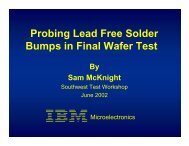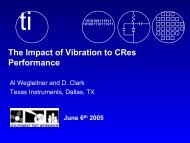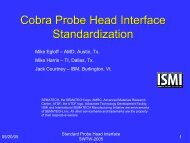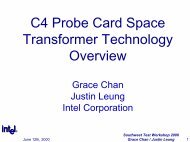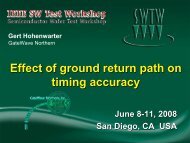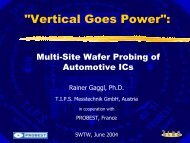Key Methods in Reducing Pad Crack Risk at Probing Low-k Wafers
Key Methods in Reducing Pad Crack Risk at Probing Low-k Wafers
Key Methods in Reducing Pad Crack Risk at Probing Low-k Wafers
You also want an ePaper? Increase the reach of your titles
YUMPU automatically turns print PDFs into web optimized ePapers that Google loves.
<strong>Key</strong> <strong>Methods</strong> <strong>in</strong> Reduc<strong>in</strong>g <strong>Pad</strong> <strong>Crack</strong><br />
<strong>Risk</strong> <strong>at</strong> Prob<strong>in</strong>g <strong>Low</strong>-k <strong>Wafers</strong><br />
Taiwan Semiconductor<br />
Manufactur<strong>in</strong>g Company, Ltd.<br />
Frank Hwang<br />
(E-mail:sxhwang@tsmc.com)<br />
Steve Hsu<br />
J. H. Chen<br />
MJC Probe Inc.<br />
Dean Yang<br />
(E-mail:dean.yang@mpi.com.tw)<br />
Wensen Hung<br />
Jacky Tsai<br />
1
Agenda<br />
• Prob<strong>in</strong>g Challenge on <strong>Low</strong>-k Devices<br />
• Scrub Depth Correl<strong>at</strong>es with Underne<strong>at</strong>h Layers<br />
• Scrub Depth Model Formul<strong>at</strong>ion (SDMF)<br />
• Review -2005<br />
• Experiment and Result<br />
• Constant Parameter Calcul<strong>at</strong>ion<br />
• BCF Measurement Limit<strong>at</strong>ion<br />
• Conclusion<br />
2
Prob<strong>in</strong>g Challenge on <strong>Low</strong>-k Devices<br />
1 st : Alum<strong>in</strong>um Tier<br />
Prob<strong>in</strong>g contradictory!<br />
2 nd : TaN<br />
<strong>Low</strong> Probe Force<br />
VS<br />
Contact Res.<br />
4 th : Oxide<br />
<strong>Low</strong>-k Structure<br />
3 rd : Copper<br />
<strong>Low</strong>-k experimental wafer – <strong>Pad</strong> m<strong>at</strong>rix cross section<br />
Tighter BCF Spec W<strong>in</strong>dow<br />
VS<br />
Analyser Accuracy<br />
Contact Force Uniformity<br />
VS<br />
Manufacture Devi<strong>at</strong>ion<br />
Multiple Touchdown<br />
VS<br />
<strong>Pad</strong> <strong>Crack</strong> <strong>Risk</strong><br />
3
Prob<strong>in</strong>g Challenge on <strong>Low</strong>-k Devices<br />
Wh<strong>at</strong> Should Be Concerned on <strong>Low</strong>-k?<br />
• Except <strong>Pad</strong> Void (PV), wh<strong>at</strong> risks will be suffered when<br />
prob<strong>in</strong>g <strong>Low</strong>-k wafer?<br />
• In comparison with the low-k defects, It’s “lucky” to suffer<br />
PV, because of the observable defects where after<br />
alum<strong>in</strong>ium layer removal, copper is physically exposed on<br />
TaN surface.<br />
• How about the scrub below?<br />
It’s OK or NG? In fact, microscope and wafer <strong>in</strong>spector<br />
show you “No PV.”<br />
Al Remove<br />
4
Prob<strong>in</strong>g Challenge on <strong>Low</strong>-k Devices<br />
Hidden Underne<strong>at</strong>h Layer Deform<strong>at</strong>ion<br />
• No PV ≠ Free Damage<br />
BCF:4gw/mil Tip Dia.=8um<br />
OD= 45μm Probe:6 times<br />
Cross<br />
Section<br />
Al<br />
BCF:4gw/mil Tip Dia.=14um<br />
OD=45μm Probe:6 times<br />
Deform<strong>at</strong>ion<br />
Cu<br />
Serious Destruction<br />
5
Prob<strong>in</strong>g Challenge on <strong>Low</strong>-k Devices<br />
Initial Prob<strong>in</strong>g Damage<br />
• After Al was removed, we found micro scr<strong>at</strong>ches<br />
and cracks as below images:<br />
OD= 65μm<br />
TD=6 times<br />
Tip Dia.=8μm<br />
BCF=4gw/mil<br />
Scrub<br />
direction<br />
Slight Medium Serious<br />
• Evalu<strong>at</strong>ion showed the probability of prob<strong>in</strong>g damage:<br />
TaN <strong>Crack</strong> > Underly<strong>in</strong>g Deform<strong>at</strong>ion > <strong>Pad</strong> Void<br />
• Safe prob<strong>in</strong>g method is to prevent TaN-crack!<br />
6
Scrub Depth Correl<strong>at</strong>es with Underne<strong>at</strong>h layers<br />
Underne<strong>at</strong>h Layer Evalu<strong>at</strong>ions<br />
• Measurements identified underne<strong>at</strong>h layer deform<strong>at</strong>ion risk was<br />
<strong>at</strong> stake.<br />
Unacceptable!<br />
Scrub Depth(um)<br />
1.8<br />
1.6<br />
1.4<br />
1.2<br />
1<br />
Scrub Depth of 4gw/mil Probe<br />
○PV Found by microscope<br />
TD 2 2 2 2 4 4 4 4 6 6 6 6<br />
OD(um) 45 55 65 75 45 55 65 75 45 55 65 75<br />
Depth(um) 1.2 1.4 1.4 1.3 1.4 1.5 1.4 1.4 1.5 1.6 1.6 1.5<br />
Parameters<br />
7
Scrub Depth Correl<strong>at</strong>es with Underne<strong>at</strong>h layers<br />
Acceptable Scrub Depth Region<br />
• Monitor the TaN layers of shallow scrubs.<br />
Acceptable<br />
Dangerous<br />
Smooth Smooth Smooth Wavy<br />
Scrub Depth<br />
30% of α<br />
Scrub Depth<br />
54% of α<br />
Scrub Depth<br />
60% of α<br />
Scrub Depth<br />
86% of α<br />
α= Thickness of Al Layer<br />
8
Scrub Depth Correl<strong>at</strong>es with Underne<strong>at</strong>h layers<br />
Scrub Depth Control is Necessary<br />
<strong>Low</strong>-k devices are highly sensitive to prob<strong>in</strong>g force issue, more<br />
severely is the unobservable physical damage <strong>in</strong>side the pad.<br />
Hidden damage not seen <strong>at</strong> wafer <strong>in</strong>spect after prob<strong>in</strong>g, but<br />
identified <strong>at</strong> test failure dur<strong>in</strong>g packag<strong>in</strong>g/f<strong>in</strong>al test.<br />
Experiment and evalu<strong>at</strong>ion works <strong>in</strong>dic<strong>at</strong>ed the safety band<br />
prob<strong>in</strong>g depth region is fallen below 60% of total Al thick.<br />
Efficient methodology to control the scrub depth is proposed by<br />
monitor<strong>in</strong>g the Kyy as the primary dom<strong>in</strong>ant factor.<br />
Cont<strong>in</strong>u<strong>in</strong>g the last year present<strong>at</strong>ion on SWTW 2005, the<br />
proposed SDMF will be demonstr<strong>at</strong>ed aga<strong>in</strong> as an effective<br />
backend assessment methodology to prevent the prob<strong>in</strong>g<br />
damage.<br />
9
Scrub Depth Model Formul<strong>at</strong>ion (SDMF)<br />
PV Case <strong>in</strong> TSMC<br />
• Problem description<br />
• <strong>Pad</strong> void by 1 st layer needle<br />
2005 SWTW<br />
Repe<strong>at</strong>ed PV p<strong>at</strong>terns<br />
10
Scrub Depth Model Formul<strong>at</strong>ion (SDMF)<br />
Primary Factors of Experiment I & II<br />
By choos<strong>in</strong>g all critical parameters, a two-level L8 orthogonal array<br />
experiment I has been performed, the <strong>in</strong>fluential factors have been<br />
determ<strong>in</strong>ed as follow:<br />
Primary dom<strong>in</strong>ant factors tip length, tip diameter<br />
Secondary dom<strong>in</strong>ant factors stiffness K yy , needle diameter<br />
From TSMC mass production test<strong>in</strong>g, three critical parameters were<br />
chosen to perform experiment II with a L9 three-level sett<strong>in</strong>g. The<br />
summarized results are:<br />
Primary dom<strong>in</strong>ant factors tip length, stiffness K yy<br />
Secondary dom<strong>in</strong>ant factors tip diameter<br />
The slight vari<strong>at</strong>ion <strong>in</strong> results of these two experiments, it was<br />
recognized th<strong>at</strong> these experiments still had uncontrolled noise.<br />
2005 SWTW<br />
It is concluded th<strong>at</strong> these two experiments <strong>in</strong>dic<strong>at</strong>ed th<strong>at</strong> tip length,<br />
tip diameter, stiffness K yy were the three most <strong>in</strong>fluential primary<br />
parameters.<br />
11
Scrub Depth Model Formul<strong>at</strong>ion (SDMF)<br />
Theory, Experiment and Verific<strong>at</strong>ion<br />
• Constant values B & C were<br />
found from curve fitt<strong>in</strong>g.<br />
U<br />
z<br />
=<br />
=<br />
C<br />
C<br />
F<br />
y<br />
D<br />
2005 SWTW<br />
D<br />
( BK + K ) D<br />
yx<br />
yy<br />
y<br />
1200<br />
1000<br />
Curve Fitt<strong>in</strong>g Result<br />
Unit :<br />
U<br />
z<br />
: nm<br />
800<br />
Uz (nm)<br />
600<br />
400<br />
200<br />
0<br />
R 2 = 0.835<br />
K<br />
D<br />
yx<br />
y<br />
,K<br />
: mil<br />
D :μm<br />
yy<br />
: gw/mil<br />
0 0.5 1 1.5 2<br />
Fy/D (gw/um)<br />
12
Scrub Depth Model Formul<strong>at</strong>ion (SDMF)<br />
TheoryⅡ, ExperimentⅡ, and Verific<strong>at</strong>ionⅡ<br />
• Experiment background<br />
• Applicability of the model is evalu<strong>at</strong>ed.<br />
• Two more parameters <strong>in</strong>cluded:<br />
(1) Three most commonly used prober mach<strong>in</strong>es<br />
(2) Different needle diameter (4 mils)<br />
• Prober set-up based on TSMC production used methods.<br />
• Results<br />
Prober<br />
Probe<br />
Type<br />
OD<br />
(μm)<br />
Tip Dia.<br />
(μm)<br />
Tier<br />
Stiffness-Kyx<br />
(gw/mil)<br />
Stiffness-Kyy<br />
(gw/mil)<br />
UF200<br />
UF3000<br />
TEL P12<br />
40<br />
60<br />
75<br />
8<br />
13<br />
1-3<br />
1st: 7.28<br />
2nd: 5.23<br />
3rd: 4.19<br />
2<br />
Additional set up notes:. undershoot <strong>at</strong> UF prober is 25 um, while on TEL P12, double<br />
touchdown function is activ<strong>at</strong>ed.<br />
13
Scrub Depth Model Formul<strong>at</strong>ion (SDMF)<br />
TheoryⅡ, ExperimentⅡ, and Verific<strong>at</strong>ionⅡ<br />
• R-square was <strong>in</strong> high agreement for UF200<br />
◆ Actual Measurement d<strong>at</strong>a<br />
— Fitt<strong>in</strong>g Curve<br />
14
Scrub Depth Model Formul<strong>at</strong>ion (SDMF)<br />
TheoryⅡ, ExperimentⅡ, and Verific<strong>at</strong>ionⅡ<br />
• UF3000 also showed appreciable agreement<br />
◆ Actual Measurement d<strong>at</strong>a<br />
— Fitt<strong>in</strong>g Curve<br />
15
Scrub Depth Model Formul<strong>at</strong>ion (SDMF)<br />
TheoryⅡ, ExperimentⅡ, and Verific<strong>at</strong>ionⅡ<br />
• R-square showed lower fitt<strong>in</strong>g agreements.<br />
• Prober chuck movement mechanism was <strong>at</strong>tributed as major<br />
factor <strong>in</strong> the result vari<strong>at</strong>ion.<br />
• Initial guess is TEL P12 hav<strong>in</strong>g deeper prob<strong>in</strong>g height than<br />
UF families.<br />
◆ Actual Measurement d<strong>at</strong>a<br />
— Fitt<strong>in</strong>g Curve<br />
16
Scrub Depth Model Formul<strong>at</strong>ion (SDMF)<br />
TheoryⅡ, ExperimentⅡ, and Verific<strong>at</strong>ionⅡ<br />
• SDMF – Constant parameter calcul<strong>at</strong>ion<br />
【UF200】<br />
Two normal TDs scrubbed<br />
2~22% deeper than s<strong>in</strong>gle<br />
TD. (see blue vs. red l<strong>in</strong>e)<br />
25um undershoot TDs has<br />
15~30% deeper scrub<br />
mark than the nonundershoot<strong>in</strong>g<br />
one.<br />
(see green vs. red l<strong>in</strong>e)<br />
17
Scrub Depth Model Formul<strong>at</strong>ion (SDMF)<br />
TheoryⅡ, ExperimentⅡ, and Verific<strong>at</strong>ionⅡ<br />
• SDMF – Constant parameter calcul<strong>at</strong>ion<br />
【UF3000】<br />
Two common TDs<br />
gener<strong>at</strong>ed 25~45% deeper<br />
scrub than with only 1 TD.<br />
(see blue vs. red l<strong>in</strong>es)<br />
Activ<strong>at</strong><strong>in</strong>g undershoot<br />
25um, scrubs became<br />
0~15% deeper than non<br />
activ<strong>at</strong>ed one.<br />
(see green vs. red l<strong>in</strong>es)<br />
18
Scrub Depth Model Formul<strong>at</strong>ion (SDMF)<br />
TheoryⅡ, ExperimentⅡ, and Verific<strong>at</strong>ionⅡ<br />
• SDMF – Constant parameter calcul<strong>at</strong>ion<br />
【TEL P12】<br />
“TEL double touchdown”<br />
function physically differs with<br />
UF’s “undershoot function.”<br />
Two normal TDs’ scrub marks<br />
were 4~9% deeper than the<br />
one by s<strong>in</strong>gle TD.<br />
(blue vs. red)<br />
After activ<strong>at</strong><strong>in</strong>g “double<br />
touchdown”, scrub is<br />
<strong>in</strong>creas<strong>in</strong>gly 8~17% deeper<br />
than non-activ<strong>at</strong>ed one.<br />
(green vs. red)<br />
19
Scrub Depth Model Formul<strong>at</strong>ion (SDMF)<br />
Summary<br />
SDMF results aga<strong>in</strong> showed the high level of quantit<strong>at</strong>ive<br />
prediction agreement with the correspond<strong>in</strong>g experimental<br />
measurement d<strong>at</strong>a.<br />
“L<strong>in</strong>ear Scrubb<strong>in</strong>g / Slope Scrubb<strong>in</strong>g” based assumption of SDMF<br />
is theoretically and experimentally proven to be capable of<br />
predict<strong>in</strong>g the scrub depth the complex scrubb<strong>in</strong>g action.<br />
Constant parameter modific<strong>at</strong>ion factors of prober <strong>in</strong>clud<strong>in</strong>g setup<br />
and multiple TDs functions, still need further st<strong>at</strong>istic sampl<strong>in</strong>g<br />
d<strong>at</strong>a to obta<strong>in</strong> accur<strong>at</strong>e results.<br />
Measurement errors existed <strong>in</strong> the experimental d<strong>at</strong>a is still<br />
acceptably tolerable as to be used <strong>in</strong> eng<strong>in</strong>eer<strong>in</strong>g level applic<strong>at</strong>ion.<br />
Production d<strong>at</strong>a feedback is always an on-go<strong>in</strong>g process for<br />
better modific<strong>at</strong>ion results of certa<strong>in</strong> constant values of the model.<br />
20
BCF Measurement Limit<strong>at</strong>ion<br />
Analyzer, St<strong>at</strong>istic, Experiment<br />
• BCF control is unavoidable for low-k prob<strong>in</strong>g<br />
• How to address a common BCF def<strong>in</strong>ition by suppliers<br />
and vendors ?<br />
• Currently the <strong>in</strong>dustry available BCF measurement<br />
tool<strong>in</strong>g (ex. Equipment A) showed spec as below:<br />
Simply st<strong>at</strong>es:<br />
With measured value 1gw/mil, it will have confidence <strong>in</strong>tervals 99.7%<br />
th<strong>at</strong> the devi<strong>at</strong>ion range should fall from 0.75~1.25 gw, also denoted as (1gw ± 25%)<br />
21
BCF Measurement Limit<strong>at</strong>ion<br />
Analyzer, St<strong>at</strong>istic, Experiment<br />
12%<br />
(1)BCF Spec:4gw/mil ±20%<br />
(2)Accuracy:±0.25gw @3σ<br />
(1)BCF Spec:1gw/mil ±20%<br />
(2)Accuracy:±0.25gw @3σ<br />
10%-offset BCF Measure<br />
100% confidence with<strong>in</strong> Spec.<br />
10%-offset BCF Measure<br />
88% confidence with<strong>in</strong> Spec.<br />
As metrology accuracy has been pushed to its limit, allowable manufacture devi<strong>at</strong>ion suffers<br />
more and more tighter tolerance. New BCF metrology pl<strong>at</strong>form is urgently needed.<br />
22
BCF Measurement Limit<strong>at</strong>ion<br />
Analyzer, St<strong>at</strong>istic, ExperimentⅠ<br />
• At low BCF values, measurement accuracy is degraded to<br />
marg<strong>in</strong>al range<br />
Average Standard Devi<strong>at</strong>ion:<br />
σ Ave<br />
-TSMC is 0.065<br />
σ Ave<br />
-MPI is 0.075<br />
BCF under 3σ confidence <strong>in</strong>terval:<br />
TSMC≒μ±0.195 4 gw/mil ±5%<br />
MPI ≒μ±0.225 4 gw/mil ±5%<br />
Average Standard Devi<strong>at</strong>ion:<br />
σ Ave<br />
-TSMC is 0.033<br />
σ Ave<br />
-MPI is 0.025<br />
BCF under 3σ confidence <strong>in</strong>terval:<br />
TSMC≒μ±0.1 1 gw/mil ±10%<br />
MPI ≒μ±0.075 1 gw/mil ±7.5%<br />
Accuracy is<br />
gett<strong>in</strong>g worse!<br />
23
BCF Measurement Limit<strong>at</strong>ion<br />
Analyzer, St<strong>at</strong>istic, ExperimentⅡ<br />
Procure a qualified<br />
low-k probe card.<br />
Only 85% could<br />
s<strong>at</strong>isfy the spec-<br />
1gw/mil±20%<br />
Carried out 5 repetitive<br />
BCF measurements<br />
from selected 50 p<strong>in</strong>s.<br />
For required spec<br />
1gw/mil ±20%, sigma<br />
must <strong>at</strong>
Conclusion<br />
• High density of mechanically weak structural layers of IC pad<br />
<strong>in</strong>troduced <strong>in</strong> low-k wafers will <strong>in</strong>crease the pad crack possibilities.<br />
• Now TSMC keeps practic<strong>in</strong>g the SDMF as the standard guidel<strong>in</strong>e<br />
for monitor<strong>in</strong>g and controll<strong>in</strong>g the prob<strong>in</strong>g scrub marks <strong>in</strong><br />
achiev<strong>in</strong>g the robust wafer sort.<br />
• SDMF results can also be further implemented <strong>in</strong>to probe card<br />
design <strong>in</strong> order to obta<strong>in</strong> acceptable probe depth.<br />
• SDMF was aga<strong>in</strong> valid<strong>at</strong>ed experimentally under consider<strong>at</strong>ion of<br />
more complete practical prob<strong>in</strong>g parameters. However, prober<br />
set-up (particularly chuck movement) still considered as important<br />
factor.<br />
• Available BCF metrology is recently <strong>at</strong> its bottleneck limit, for<br />
low-k card, new enhancement tool<strong>in</strong>g to obta<strong>in</strong><strong>in</strong>g accur<strong>at</strong>e<br />
measurement is under request.<br />
25
Q&A<br />
26



